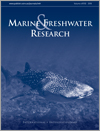MF17393Comparing length-measurement methods and estimating growth parameters of free-swimming whale sharks (Rhincodon typus) near the South Ari Atoll, Maldives
 , Joana Figueiredo, Jeremy J. Vaudo, James Hancock, Richard Rees and Mahmood Shivji
, Joana Figueiredo, Jeremy J. Vaudo, James Hancock, Richard Rees and Mahmood Shivji
Age and growth of free-swimming whale sharks observed over a 10-year period was estimated at South Ari Atoll, Maldives. Measurement methods were compared and von Bertalanffy growth parameters were calculated for males and combined sexes. Our estimates were similar to those from traditional techniques, suggesting that our methods could be used when individuals can be distinguished and re-identified over time.




